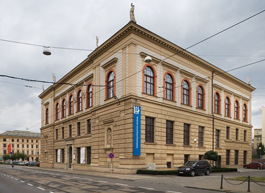
The Moravian Gallery will abolish admission fees to its permanent exhibitions starting in December
 |
The National Gallery in Prague had considered abolishing entrance fees years ago, but the then-director Milan Knížák requested that the Ministry of Culture, as its founder, compensate for the loss of income by increasing the budget; no director of the NG has been able to negotiate this so far. "The abolition of entrance fees at the NG is a constant dream of its management, but the financial situation of this state cultural institution does not allow for this step at the moment," NG spokesperson Eva Kolerusová said today to ČTK.
The Gallery of the Capital City of Prague, which is funded by the city, does not plan any changes in the near future either. It does not have permanent exhibitions in its venues, only temporary ones, some of which last many months. The gallery will maintain a discount system for seniors, Opencard holders, and students, spokesperson Kristýna Kočová told ČTK.
Until now, visitors interested in viewing the permanent exhibitions in the Moravian Gallery had to pay 60 crowns, while the discounted entrance fee was 30 crowns. The gallery will continue to charge an entrance fee for short-term exhibitions, which are the main attraction for visitors. The Moravian Gallery recorded a total of 121,090 entries last year, including accompanying events, educational programs, and museum nights. 9,426 visitors viewed the permanent exhibitions, while temporary exhibitions attracted 53,812 people.
"We expect a significant increase in attendance following the removal of entrance fees, but we also want art to be more accessible to everyone in Brno," said the gallery director Jan Press, who based his decision on the example of London’s museums and galleries.
"Other changes we are preparing will also help increase attendance and encourage people to stay longer in the Moravian Gallery — next year we plan to open two new cafes in Pražák and Governor's Palaces and significantly expand the museum shops," Press added. Due to the decision to close the traditional café Podobrazy in the Governor's Palace, Press faced criticism from part of the public. He argued that the jazz café, aimed mainly at young visitors, does not meet the demands of a modern museum business.
The permanent collections of the Moravian Gallery in three Brno palaces hide numerous artistic treasures from various periods. The central piece of the old art exhibition is Peter Paul Rubens' painting "The Head of Medusa"; visitors will also see canvases by Lucas Cranach and Franz Anton Maulbertsche. Czech modern art and interwar avant-garde are richly represented in the gallery's collections, including works by František Foltýn, Antonín Procházka, Václav Špála, Emil Filla, and Josef Čapek.
Visitors to the permanent exhibitions will be able to contribute to the activities of the largest art museum in the Czech Republic with at least a symbolic donation at their discretion starting in December. The abolition of entrance fees for permanent exhibitions does not apply to the other two buildings that the Moravian Gallery manages. The Jurkovič Villa in Žabovřesky and the Birth House of Josef Hoffmann in Brtnice near Jihlava will continue to be open only to paying visitors.
The English translation is powered by AI tool. Switch to Czech to view the original text source.
0 comments
add comment












